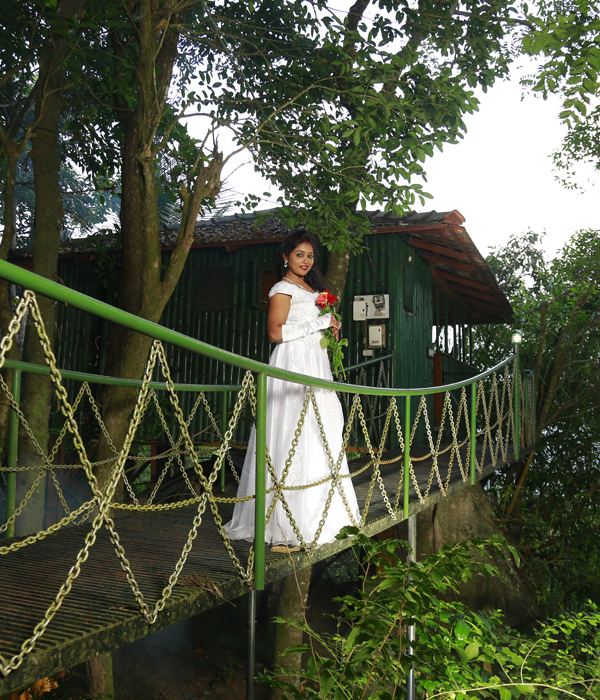Resorts in Wayanad | Wayanad Resorts
Wayanad Cybele Hill Kerala resorts has come to be known as one of the finest resorts in wayanad. Our accommodation in wayanad for tourists and residents.Wayanad Cybele Hill resort is a premium resort embeded in the greenery of wayanad, the district handpicked as one of the best tourist destination in kerala by National Geogrpahical Society. With the passion of hospitality and with the intention to focus wayanad globally as a best tourist destination, Mr. Mathew, the brain behind this venture is presenting an unexplored area of wayanad - named Wayanad Cybele hill Resort for travellers across the globe ! As the name stands for, Wayanad Cybele hill resort is really the Godess of Nature in all aspects ! Cool an soothing ambience, spectacular view points, Extreme of hospitality together with professional administration keeps Wayanad Cybele hill resorts outstanding and commendable among other resorts at wayanad. We are sure that visit to Wayanad Cybele Hill shall be once in a life time experience for everybody.
The Village Life Experience
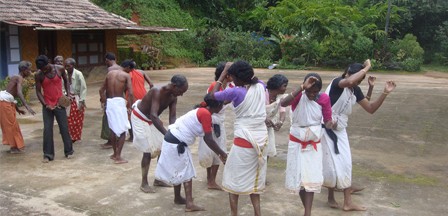
The Wayanad Cybele Hill Resort is nearby adivasi tribal village. The guests can feel and realize the village life style of tribal directly while staying in Wayanad Cybele Hill Resort. Their life style is different compared to others, at the festival times the tribal dance with music it's quite interesting to watch.
The adivasi life style is no longer feasible for these women and men. They share their daily experiences and reflect on the dilemma of being an adivasi in the modern world. What it means to speak one's own language in public, wearing one's traditional dress in main stream society and the impact of modern agriculture.
Wayanad, Kerala.

Wayanad in Kerala is an Indian district in the north-east of Kerala state with administrative headquarters at the municipality of Kalpetta. It is set high on the Western Ghats with altitudes ranging from 700 to 2100 meters. The district was formed on 1 November 1980 as the 12th district in Kerala by carving out areas from Kozhikode and Kannur districts. About 885.92 sq.km of area of the district is under forest. Wayanad has three municipal towns - Kalpetta, Mananthavady and Sulthan Bathery. There are many resorts in Wayanad and indigenous tribals in this area.
Wayanad district, Kerala is bordered by Karnataka to north and north-east, Tamil Nadu to south-east, Malappuram to south, Kozhikode to south-west and Kannur to north-west. Pulpally in Wayanad boasts of the only Lava- Kusha temple in Kerala and Vythiri has the only mirror temple in Kerala which is a Jain temple. The edicts and caves of Ambukuthi Mala and other evidence state that the place is as old as the beginning of the New Age Civilisation.
Etymology
The name 'Wayanad' is derived from 'Vayal Naatu' (Malayalam) which translates to 'the land of paddy fields' in English.
History
Veera Kerala Varma Pazhassi Raja, painting by Raja Ravi Varma
Historians believe that the human settlements existed in these parts for at least ten centuries before Christ. Much evidence of New Stone Age civilisation can be seen in the hills throughout the present day Wayanad district. The Edakkal Caves in Wayanad have 6000-year-old rock engravings from the Neolithic age. The recorded history of this district is available only from the 18th century. In ancient times, this land was ruled by the Rajas of the Veda tribe.
The Kutumbiyas (Kudumbiyas)
The two caves of Ampukuthimala (Edakkal Caves in Wayanad) in Sulthan Bathery, with pictures on their walls and pictorial writings, speak volumes of a bygone civilisation. At the foot of the Edakal Male (hill) caves, Kannada inscriptions belonging to Canarese chieftain Vishnu Varma of Kutumbiya (Kudumbiya) clan of Mysore dating to c. 5th century CE were discovered which read - 'Palapulitaanamtakaari' or 'Pala pulinânam ta-kâri', Sri Vishnu Varma Kutumbiya Kulavardhanasya li..it..a..'. As per Hultzch, an epigraphist from the department of epigraphy, Madras, it speaks of the glorious descendant of Kutumbiya clan, Kannada chieftain, Vishnu Varma, as one who killed many tigers. Some scholars speculate this Kutumba clan to be the same as the Kurumbas found there.
The Kadambas
In the 11th century AD, Gangas were dethroned from Bayalnad by the Kadamba dynasty of North Canara. Wayanad was at that time divided into two portions - Bira Bayalnad and Chagi Bayalnad. One of the Mysore inscriptions (alluding perhaps to the treacherous beauty of the country, which attracted the stranger and then laid him low with malaria) says 'an adulteress with black waving curls, as adulteress with full-moon face, an adulteress with endless side-glances, an adulteress with adorned slim figure was this storeyed mansion, the double Bayalnad'. Kadamba Bayalnad emerged as a rule in the 11th century under their chief Raviyammarasa with Kirttipura in Punnad their capital. Kanthirava (1090 CE) was described as ruling Chagi-Bayalnad. Iravi-Challamma (1108 CE) was the ruler of Bira-Bayalnad.
The Hoysalas
In 1104 AD Vishnuvardhana of Hoysala invaded Bayalnad followed by Vijayanagara dynasty in the 14th century. A Kadamba king, Mukkanna-Kadamba ruled Bayal-nad in and around 1138 CE.
The Vijayanagara empire
A feudatory chieftain of Sangama dynasty of Vijaynagar, Immadi Kadamba Raya Vodeyayya of Bayalnad Kadambas, is said to have ruled Bayalnad.
The Mysore Wodeyars and the Sultans
In 1610 AD Udaiyar Raja Wadiyar of Mysore drove out Vijayanagara General and became the ruler of Bayalnad and the Nilgiris. Bayalnad is the present Wayanad. When Wayanad was under Hyder Ali's rule, the ghat road from Vythiri to Thamarassery was constructed. Then the British rulers developed this route to Carter road. When Wayanad was under Tipu Sultan's rule British invasion started. Tussle and turbulent times followed. The British claimed Wayanad under the 1792 treaty of Srirangapatna citing it was part of Malabar. Tipu Sultan went in appeal before the Governor General. Considering his arguments, relying on the successive Karnataka rule for centuries in Wayanad and its geographical detachment from Malabar, in 1798, Governor General Lord Mornington declared by proclamation that Wayanad had not been ceded to the East India Company by the treaty of 1792. Consequently, the British troops withdrew from Wayanad conceding to Tipu's rule. In 1799, after the fall of Sultan, the British handed over Wayanad by the treaty of 1799 to the Raja of Mysore. But by a supplementary treaty dated 29 December 1803 the East India Company repossessed Wayanad and thereafter administrated by Col. Arthur Wellesley from Srirangapatna and North Wayanad came under the rule of the Pazhassi Raja dynasty of ancient Kottayam.
British Rule
In the end, the British could get only the dead body of the Rajah, who killed himself somewhere in the interior of the forest. Thus, Wayanad fell into the hands of the British and with it came a new turn in the home of this area. The British authorities opened up the plateau to the cultivation of tea and other cash crops by constructing roads across the dangerous slopes of Wayanad, to Kozhikode and Thalassery. Later, they extended these new roads to the cities of Mysore and Ooty through Gudalur. Settlers emigrated from all parts of Kerala and the fecund lands proved a veritable goldmine with incredible yields of cash crops. Agriculture Cultivation started broadly after 1900 A.D onwards. Wayanad eventually became part of Kerala despite its geographical delimitations and political descent in 1956 on State's reorganisation. Even now there is a considerable Kannada speaking population and the reminiscence of centuries old Karnataka rule is omnipresent in Wayanad. When the State of Kerala came into being in November 1956, Wayanad was part of Kannur district. Later, south Wayanad was added to Kozhikode district. To fulfil the aspirations of the people of Wayanad for development, North Wayanad and South Wayanad were carved out and joined together to form the present district of Wayanad. This district came into being on 1 November 1980 as one the twelve districts of Kerala, consisting of three taluks; Vythiri, Mananthavady, and Sulthan Bathery in Wayanad.
Tribes in Wayanad
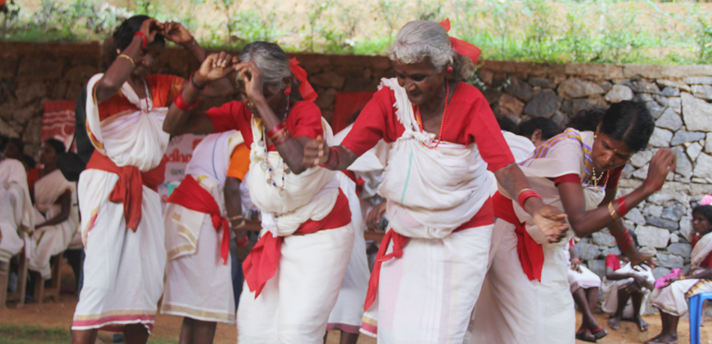
The Wayanad have the largest tribal population in Kerala with 8 scheduled tribes including Adiyan, Paniyan, Mullukkurman, Kurichyan, Vettakkuruman Wayanad Kadar, Kattuniakkan and Thachaanadan Mooppan. These communities have a number of symbolic oral narratives.
Adiyan at Wayanad
Adiyans are a matrilineal Tribal group, who were treated as bonded slave labourers by the landlords up to 1976. Now majority of them are agricultural labourers and some of them are marginal agriculturalists. They spoke the Adiya language as their mother tongue.
Kattuniakkan at Wayanad
A particularly Vulnerable Tribal group of Wayanad. Jenu Kurumban and Ten Kurumban are the synonyms used for the Kattunayakan community. They spoke the Kattunaikka language, a dialect of Kannada and Malayalam. They are patrilineal and a forest dwelling, hunting and gathering community.This is the largest population among PVTG in Kerala with a total population of19995 (Male- 9953, Fema
Kurichyan at Wayanad
They are the second largest community among Scheduled Tribes with a total population of 35909 (Male- 18129, Female-17780)
Mullukkurman in Wayanad
A patrilineal and patrilocal tribal agriculturalist community found in Wayanad. The community members are experts in hunting and their spoken language is Mullukkuruma language. The total population is 21375 (Male- 10625, female-10750)
Paniyan in Wayanad
A Patrilinial slave tribe community until the 1970s Bonded labour act, distributed in Wayanad, Kannur, Kozhikode and Malappuram. They are the largest single tribal community with a population of 92787 (Male-45112, female- 47675). Their language is a dialect known as Paniya Language and nowadays they are agricultural labourers.
Thachaanadan Mooppan in Wayanad
Thachaanadan Mooppan is a matrilineal community. In earlier days they were shifting cultivators and hunters. Nowadays they earn through agricultural labour work. They are experts in carpentry and basket making. Their total population is 1649, and consists of 814 males and 835 females.
Vettakkuruman in Wayanad
Vettakkuruman also a patrilineal tribal community. They are the artisan tribes and well versed in pottery, carpentry, blacksmithery and tools making and Basketry. Their language is known as Bettakkuruma language. The population of Vettakuruman is 6482 consisting of 3193 males and 3289 females.
Wayanad Kadar in Wayanad
They are found in Kozhikode and Wayanad district and entirely a different generic stock from Kaders of Cochin. They are matrilineal marginal tribes with a population of 673 consists of 348 males and 325 females.
Geography
Wayanad scenery on NH 766 Kozhikode-Kollegal
Wayanad district stands on the southern tip of the Deccan plateau and includes part of the Western Ghats. Quite a large area of the district is covered by forest but the continued and indiscriminate exploitation of the natural resources point towards an imminent environmental crisis. There are a lot of trekking points in this district. Chembra Peak (2,100m) is the highest peak in the Wayanad district. Banasura Hill (2,079m) is also similar to the height of Chembra hill.
The district is blessed with rich water resources. There are east flowing and west flowing rivers in the region. One of the major rivers in the district is Kabini River, a tributary of River Kaveri; it is also one of the only three east flowing rivers in Kerala. Kabani has many tributaries including Thirunelli River, Panamaram River and Mananthavady River. All these rivulets help form a rich water resource as well as a distinct landscape for the district. Various streams flow into the Panamaram rivulet while it passes through the mountain gorges and finally the river falls down into Panamaram Valley. After flowing through the district for a certain distance, River Panamaram joins Mananthavady River, which originates from the lower regions of the peak called 'Thondarmudi'.
Banasura Sagar Dam in Wayanad
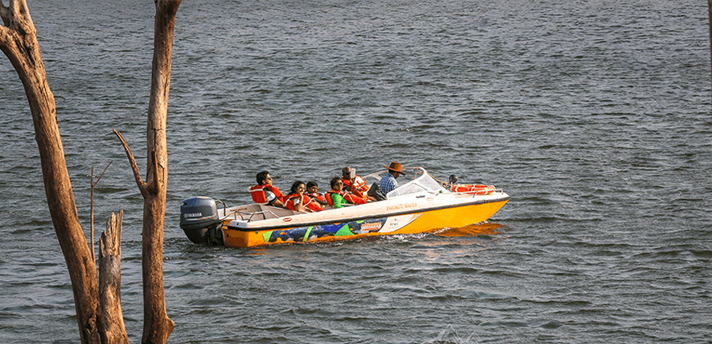
Banasura Sagar Dam in Wayanad across the Karamanathodu River, a tributary of River Kabini, in Kalpetta, is considered to be the largest earth dam in India and the second largest in Asia. The dam is ideally placed in the foothills of Banasura hills, which got its name from 'Banasura', the son of King Mahabali, the famous ruler of Kerala. The dam here was constructed on behalf of the Banasura Sagar project in 1979, to support the Kakkayam Hydroelectric power project and to meet the water demand for irrigation and drinking purposes. The dam, located around 21 km away from Kalpetta is a tourist destination in Wayanad. Banasura dam is made up of massive stacks of stones and boulders.
Karapuzha Dam in Wayanad
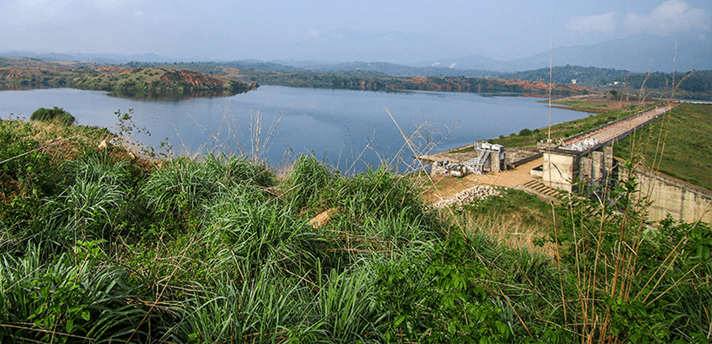
Karapuzha Dam in Wayanad is considered to be one of the biggest earth dams in India, which has been constructed on the Karapuzha River, a tributary of the Kabini River. Vazhavatta in Vythiri taluk of Wayanad district for providing irrigation to an area of 5580 ha (CCA) say 5600 hectare in Vythiri and Sultan Bathery taluks of Wayanad district of Kerala. The reservoir has a gross storage capacity of 76.50 M Cum and live storage capacity of 72.00 M Cum.
Flora and fauna
The soil and climate of Wayanad are suitable for horticulture on a commercial basis. For promoting the cultivation of vegetables and raising of orchards, the Kerala Agricultural University is running a regional Agricultural Research Station at Ambalavayal.
Elephants, bears and other wild animals from the neighbouring wild life sanctuaries of Karnataka and Tamil Nadu, stray into the Begur forest range and the forests around Muthanga, which is 20 kilometres away from the town of Sultan Bathery.
Franky's narrow-mouthed frog was recently discovered in Wayanad district.
Facilities Nearest Places Activities Explore Wayanad Tour Packages
www.wayanadcybelehillresorts.com



